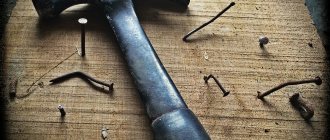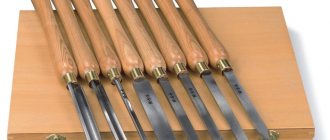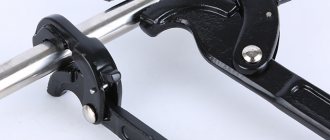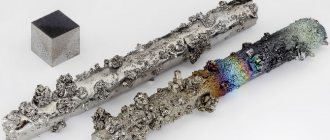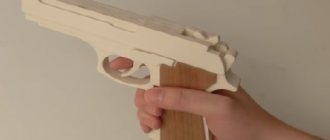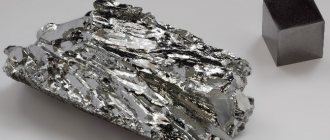A hand-held welding tool - an extruder - today is no longer something unusual or supernatural. Thanks to modern technologies, it has become possible to create such a tool with your own hands.
The extruder is designed to make permanent connections of various plastic products, which are carried out by feeding a molten mass of material into a heated bath formed by the edges of the samples being welded.
This tool is used for the production of containers, sheet products, and repairing damage to plastic structures, for example, soldering car bumpers made of plastic.
The extruder has no weak points, it has a long service life and is easy to operate. Enterprising people purchase semi-finished plastic products and use this tool to make unique designs. One of these projects can be about. A pontoon was used as a base for it.
Extruder for feed: drawings and useful recommendations
A simple to use feed extruder makes it possible to independently produce compound feed for animals. This device is considered an indispensable assistant both in large-scale agriculture and in small farms for raising animals and birds. In specialized stores, such equipment costs decent money. To save money, you can assemble the unit yourself; drawings and recommendations from specialists will serve as an auxiliary informant in this matter.
Some useful tips
The homemade device should be thoroughly checked and tested before use.
- First you need to check the reliability of all connections and fasteners.
- The unit must be installed on a flat surface; any changes will disrupt the operation of the extruder.
- Connect to the mains and let the system warm up. At this time, you can pass a small amount of flour or sunflower cake through the press, observing the shape of the emerging mass - this way you can understand whether the system has warmed up enough.
- Next is the grain supply. It must be constant to prevent the device from idling. Grain should be poured without excess, otherwise congestion may occur.
- At the outlet, the fraction of the exiting product is regulated by gradually tightening the bolt and reducing the gap of the die part.
- Once recycling is complete, the inside of the mechanism should be cleaned. Use the same flour or cake for this purpose - they will absorb the remaining grain and oil.
- To ensure that the mechanism cools down faster, clean at minimum speed. Disassembly should be carried out only with gloves to avoid burns.
The extruder, made by hand , can process no more than 40 kg of grain per hour. For a small farm this is quite enough. Food prepared by mechanical processing provides complete nutrition for pets, reducing the cost of purchasing food and reducing the time for preparing it.
What it is
An extruder is used to process grain crops into compound feed, which is much easier to digest in the stomach of animals. Processing is carried out using a press under a pressure of 60 atmospheres and at high temperature. The result is a product shaped like 20-30 mm corn sticks, but with a dense structure.
Apparatuses for preparing feed exist with different power ratings, and the volume of product produced depends on it. For a small farm, a device with a productivity of 25-45 kg/h is perfect - the price of such a device starts from 47 thousand rubles. But a large farm will require more powerful models capable of producing up to 1.5 tons per hour and they cost from 160 thousand rubles.
Extruder device
Due to high prices, equipment for processing products into mixed feed, even second-hand, is available to a narrow circle of consumers. But if you make an extruder for feed with your own hands, you can save a lot. Only in this case you need to study in detail the structure of the unit, the principle of operation, and also have all the necessary spare parts available.
Diagram of a large extruder
The design of the device includes the following elements:
- frame - serves as the basis, all the details are fixed on it;
- drive unit;
- belt;
- loading capacity;
- cuff;
- dosing screw with separate drive;
- gearbox;
- receiving tank;
- motor;
- injection screw conveyor;
- Control block;
- carved blade;
- washer;
- adjustment key.
Operating principle
In a homemade extruder, the main function is performed by the pressing mechanism. The element includes a discharge screw unit mounted in the cylinder. The blade block gives the product the shape of oblong sticks.
The functions of the electrical appliance are not limited to pressing feed. With its help, you can grind grain, carry out heat treatment and disinfection of feed, and mix different components into a single mass.
The design of the injection screw includes:
- outer part;
- internal;
- heating washers;
- outgoing auger.
Each unit is installed on a stud with a left-hand threaded part and covered with a housing made of metal material. Thanks to the keys, the revolutions flow from the main shaft to the combined auger. All components are firmly fixed to the frame.
Detailed extruder design (download)
The housing element is equipped with a hole, and the receiving part is mounted to it. The internal area is equipped with longitudinal grooves, due to which all feed components are mixed along the longitudinal side of the axis.
A pellet regulator is installed on the output part; its design includes:
- matrix block;
- output housing;
- blade pressed by a spring element to the matrix block.
The rotation of the shaft with the blade is carried out by means of a rein. You can monitor the temperature using a thermocouple mounted on the frame. The grain extruder operates from electrical voltage. But there are already modifications that run on fuel.
Making an extruder for feed with your own hands
If you have the necessary material, parts and tools, you can make an extruder with your own hands. Let's look at how to get a low-performance model.
To do this you will need:
- electric motor with a power of 2.2 kW at 3,000 rpm;
- gears from a tractor box - parts from YuMZ would be an excellent option;
- spring 8 mm;
- rod with a cross section of 5 cm;
- welding equipment.
Step-by-step work on making a feed extruder with your own hands:
- To obtain a cylinder, you will need to weld the tractor gears together. As a result, a spare part with a cross-section of 625 mm should be produced. Next, a spring with a diameter of 8 mm is mounted on the hydraulic cylindrical rod. Weld all the parts; if the seam is uneven, treat the area with a grinder.
- Using turning equipment, grind 2 axle boxes that will be used for the auger and gearbox. Weld the auger, shaft element and axleboxes into a single piece, and do not forget to insert a bearing between the last parts.
Blanks in the form of axle boxes
- The equipment head is mounted on the screw; it will act as a regulator of the die to which the nozzles are welded.
Workpiece on auger
- The auger is covered with a housing, all parts are assembled and fixed to the frame, an electric motor, belts and a starting part are also mounted. A loading container is installed on top.
In general terms, a homemade extruder is similar in external and functional characteristics to a household electric meat grinder.
VIDEO: Making a screw granulator with your own hands (Part 1)
How to use a homemade design
A grain granulator assembled with your own hands before large-scale production requires preliminary testing and verification work. Equipment should be tested in a safe environment.
Homemade extruder for the production of animal feed
- The first thing that needs to be checked is the quality of all connections, as well as fasteners and the maximum level of lifting to the stop.
- Then the device is fixed on a flat, stable surface. If the coating is shaky, the device may not perform its functions properly.
- Connect to a power source, start and leave for a few minutes to fully warm up the system. To prevent the elements from rotating in vain, you can check by passing a light product in the form of flour or cake from sunflower seeds through the mechanism. The correctness of the form determines whether the device has warmed up sufficiently.
When the “sausage” shape becomes smooth and dense, then the unit is ready to work with grain
- After the feed comes out in the desired shape, you can add the grain product. The supply of grain must be regular without stopping; the mechanism must not be allowed to function idle. You should also add raw materials in even portions so as not to load the system and create a jam.
- At the output, you need to adjust the feed fraction by periodically tightening the bolt and reducing the hole in the spinneret plate.
- At the end of the productive process, it is necessary to thoroughly clean the internal components from product residues. To do this, you do not need to disassemble the device; just pour the seed shells into the equipment. This raw material is capable of well collecting grain product particles due to the oils it contains.
- Reduce the rotation level to gradually cool the mechanism components. If you need to disassemble the device, you should wear heat-protective gloves, there is a risk of getting burned.
How the unit works
The extruder is composed of the following elements:
- frame base to which the entire installation is attached;
- drive;
- bunkers for loading grain;
- dosing screw and drive to it;
- injection screw;
- cylinder;
- receiving chamber;
- cutting knife;
- control center/controller;
- engine;
- gearbox;
- cuffs;
- belt;
- washers;
- nuts;
- adjusting key.
The main work is performed by the pressing unit. It is assembled from a forcing screw, which is inserted inside the collection cylinder. Using a matrix with a cutting knife, the resulting mass takes the form of sticks or flagella.
The injection screw consists of three stages:
- entrance part;
- middle part;
- output screw;
- heating washers.
All components are mounted on a stud with a left-hand thread. The part is closed with a metal casing. The keys transmit rotation from the main shaft to the composite screw. The entire structure is attached to the supporting frame using powerful bolts. The case has a window with an attached tray.
Inside the housing itself there are several longitudinal grooves that move components along the axis of the screw. A pellet regulator is located near the exit. It includes:
- bow body;
- matrix (disk), which regulates the process with a handle;
- roller and knife, which are pressed to the matrix by a spring.
Rotate the shaft with the knife through the leash with the fingers. The finished extrudates exit through the nose housing and the hole adjustment dial. The disk is fixed in one position with a bolt; when the position changes, the temperature and pressure level in the apparatus will change. A thermocouple placed on the housing allows you to monitor the temperature.
It runs on electricity, but new models are appearing that run on liquid fuel. Warming up occurs gradually . At the first stage, while the extruder is heating up, cake or flour is loaded into it. The grain is fed only when the system is well heated; it breaks and turns into sticks only at high temperatures and strong pressure.
Extruder. Types and device. Operation and application. Peculiarities
An extruder is a machine for the production of long products from plastic or bulk substances. The device forces the loaded materials through a thin hole under high pressure, sometimes with preheating, which causes the substance to compact. Such machines are widely used in various fields of production.
Where is the extruder used?
Extruders have found wide application in various branches of modern industry. They are used for the production of:
- Animal feed.
- Chocolate bars.
- Pasta products.
- Wires for 3D printers.
- Plastic pipes.
- Profiles made of polyvinyl chloride.
- Polyethylene film.
- Fuel briquettes.
Extruder-type equipment is found everywhere. The production of granulated animal feed, as well as pasta, long hollow plastic products, etc. could not be done without it. The systems used for certain purposes have slight differences in technical terms, but work on the same principle.
Types of extruders based on operating principle
Based on their operating principle, extruders are divided into 3 types:
- Screw.
- Plunger
- Flat-slit.
Screw
extruder is the most common. It works on the principle of a meat grinder. Inside the device there is a rotating screw with a spiral that grabs the loaded material and pushes it through a thin hole. As a result, the mass becomes compacted and becomes hard. The pressure created raises the temperature of the raw material, which increases the efficiency of welding components. These types are the cheapest compared to others. In addition to the single screw design, twin screw extruders are also available. They create even more efficient compression, but are also more expensive. Such devices are usually used for the production of feed, as well as various food industry products.
Plunger
extruders, unlike screw extruders, accurately dose the material before giving it a specific shape. Similar devices are used for processing rubber or plastic.
Flat slot
extruders are designed for the production of rolled products such as stretch film, greenhouse film, plastic and propylene sheets. In them, the heated and viscous material is squeezed out through a flat, wide slot and quickly cools, as a result of which it retains its shape. The material is supplied using a hydraulic press, auger, or other mechanism.
Feed extruders
Feed extruders are usually represented by equipment with a screw design. They are designed for processing grain crops and herbaceous plants into compound feed. There are two types of such systems. The first simply carries out extrusion, giving a long tube at the output, and the second creates finished granules.
Conventional extruders
Conventional extrusion processes whole grains into a long, crisp tube that can be crushed into flakes. Such feed is more acceptable than raw materials loaded for processing. The fact is that as a result of compression, the mass is heated. This helps to destroy the vast majority of microorganisms that can cause eating disorders. In addition, the nutrients are baked as if in an oven, which improves their absorption by the animal’s body.
In fact, thanks to extrusion, it is possible to achieve higher animal growth rates using the same volume of feed. Such equipment also has a drawback. The resulting tube often needs to be broken into flakes by hand. There is also difficulty in measuring portions. Depending on how large the flakes are, the actual weight of the product in a given volume may vary. In this regard, when measuring a portion for feeding, it is customary to weigh it rather than use measuring containers.
Granulator extruders
An extruder operating on the principle of a granulator is less effective in terms of disinfecting the loaded mass. The output is small granules that have high hardness. They are not as fragile as the food tubes of a regular extruder. In order to improve product quality, processing is often carried out using two extrusion methods at once. First, flakes are formed, which are effectively fried, after which a granulator extruder is used.
Such equipment works on the principle of a meat grinder. Rods of feed are squeezed out through the mold and cut with a rotating knife. Thanks to this, granules that are completely identical to each other are obtained. When using a granular extruder, it is not whole grain that is loaded, but previously ground mixtures. They often contain grains, vitamins, microelements, grass flour, as well as dry meat when it comes to food for dogs, cats or other carnivores.
Extruders for the food industry
Extruders are especially popular in the food industry. Similar devices are used to form various products. They work not only with dry substances, but also with wet ones. For example, products such as crab or fish sticks are made using such equipment. The loaded mass is compacted and squeezed out. Such devices often operate without heating, simply compacting the cold mass. Many bars and candies are also made using this principle. The extruded blanks are subsequently doused with hot chocolate, making the rough extruder molding invisible.
One of the oldest extruders that are used in the food industry are pasta molding machines. They also work on the screw principle. Their design is practically no different from a feed extruder. However, there is one important difference. It is not dry mass that is loaded into them, but finished dough from durum wheat. The dough, previously prepared and well rolled using rollers to a homogeneous substance, is pressed through the molding head, resulting in pasta. Next, the rotating knife cuts them at the same distance, after which the finished pasta falls onto the conveyor belt.
Pharmacological equipment
Extruders have also found their application in pharmacology. Many tablets, as well as Hematogen bars, are made using such equipment. In pharmacology, where dosage is very important, plunger rather than screw units are often used. They make it possible to ensure with high precision that each tablet fully corresponds to the required weight, since even a hundredth of a milligram of the active substance can be of great importance in treatment.
Extruders for the production of polymer products
The extruder has become a godsend for industrial enterprises that produce polymer products. The cost of using this equipment is as profitable as possible. It costs less than installations operating according to other principles, and in addition they provide quite high-quality results. Extruders have found their application in a wide variety of polymer processing areas.
How to choose a hotend?
It is worth noting that the extruder is a rather expensive part. Assembled, this spare part can cost $80–150. Moreover, the cost in Russian retail stores is not much different from that in China. It turns out that this is one of the most expensive components in the entire printing device.
That's why many 3D makers make homemade printers. They also assemble the extruder themselves, using open blueprints on the Internet. To assemble the printing unit correctly, you need to initially calculate what tasks it will solve. To do this, you need to evaluate several parameters of the future printer:
- Engine power. It directly depends on the size of the nozzle. If a 3D maker is going to make projects with greater detail, he will need a small nozzle and a powerful motor. Otherwise, the plastic may simply get stuck.
- Nozzle. As mentioned above, the diameter of the nozzle opening is selected based on the assigned tasks.
- Feed roller. This is a weak point in the printer. Often the roller slips and the filament does not flow. Printing defects appear. For example, PLA and ABS rollers interact very poorly with nylon thread.
- Extruder design. All components can be fastened into one unit by printing them on a 3D printer. Or cut it out of plywood. Both options are easy to do. However, a monolithic plastic structure will be stronger than a plywood box.
- Extruder type. It all depends on the experience of the printer and the tasks he will solve. The Bowden type extruder is said to be more accurate, but is a little more difficult to make. And in home-made entry-level designs, its advantages disappear. Direct does not print as accurately, but is easier to manufacture.
The situation with the hot-end is a little more complicated. There are two ways to go here. First: buy ready-made spare parts on the Internet, which is also not cheap. Second: do it yourself. To do this, you need to be patient and have the necessary components. We will provide more detailed instructions for assembling the hot end towards the end of this material.
Attention! If you don't want to make your own hot end, you can order one on E-bay. For example, a model from E3D. True, this part alone will cost you the price of a new extruder assembly.
Benefits of using a grain extruder
A grain extruder is one of the most significant devices for improving the quality of grains. The need to purchase it is justified by many factors. The extruder allows you to increase the quality characteristics of grains several times. Feed processed with an extruder is more economical, easier to digest and completely safe.
This technology is used both in agriculture, helping to significantly reduce feed consumption, and in the food industry to improve the quality of the final product.
Extrusion is by far the most effective way to increase the nutritional value of grains!
Description
Grain extruders are intended for the rapid production of feed, the digestibility of which is 90-95%, while the digestibility of unprocessed grain does not exceed 65%.
As a result of a short-term increase in temperature, as well as mechanical stress and artificial pressure changes, structural and chemical changes occur in the grain .
Starch, which makes up 50% of grains and is quite difficult for animals to digest, and grain protein acquire a structure that is more easily accepted by the body.
Starch is broken down into simple sugars, complex proteins and carbohydrates are broken down into simple sugars, and fiber is converted into secondary sugars. Since the temperature effect lasts only a few seconds, beneficial vitamins and minerals are completely preserved, and fungi, pests and bacteria die.
During processing, the grain seems to explode from the inside, becoming more airy and acquiring the necessary plasticity and porosity. The volume of processed grain increases by approximately 15-20% compared to the original.
Even grains affected by insects, fungi or mold are suitable for the production of animal feed using extrusion.
After processing, feed is much easier to accept by the body, since most of the work of the stomach has already been done by the apparatus. Thanks to this, the animal spends 2 times less energy on food processing. As a result, with the same volume of fed feed, weight gain increases to 40%, milk yield to 35%, and egg production of poultry to 30%.
Extruder operating principle
After the grain is fed into the bunker, the processes inside the apparatus take place without outside interference. Using vibration, the material is fed into the working area of the unit, where it is subjected to three-phase processing.
The processed material does not need to be steamed or subjected to any additional processing!
After entering the extruder, the grain undergoes heat treatment at temperatures from 110 to 160 degrees under pressure up to 40 atmospheres. When grain is released from this compartment, the pressure drops sharply, the water contained in the cells turns into steam and increases in volume 1000 times. As a result, an explosion occurs inside the grain, due to which it swells, acquires a porous structure, increases in volume and is better moldable.
After pressing through the profiling tool, a swollen strand emerges from the extruder, having the shape of a rope. If there is a cutter, the fraction size is approximately 10-50 mm.
The extrusion process occurs in approximately 30 seconds, which ensures high productivity with minimal energy consumption. Heating and compression of grain takes place without heating elements and hydraulics, only due to an electric motor.
Three extrusion methods are used:
- Cold forming;
- Warm processing;
- Hot extrusion.
No foundation is needed to install the extruder. It can be installed on any flat surface, even dirt floors!
Recommendations for use
The grain extruder is installed on a flat, flat surface. It is advisable to use the device in a room with low humidity and good ventilation. The grain is fed evenly and constantly, otherwise the compartment with the press will be overloaded. To adjust the size of the finished granules, change the sieve or tighten the matrix bolt.
Finish the work by gradually reducing the speed. After each use, the device must be disassembled and washed to avoid clogging of the working and cutting units with particles of dried food.
Usage
Extruders are used to make animal feed.
The use of this technology can significantly reduce the cost of feeding animals. In addition, when animals are switched to feeding on extruded feed, the mortality of young animals is reduced. Feed made using extruders has the ability to prevent gastrointestinal diseases in animals and significantly improve the digestive process!
Extruders are also used in the food industry. They are used to make breakfast cereals, corn sticks, chips, crackers, baby food, and diet bread.
Twin-screw extruders are also used in the production of polymers: films for bags, polystyrene and polypropylene.
However, the most common use of an extruder is to improve the feeding qualities of grain crops. Any cereal crops, soybeans, and legumes can be used as materials for making feed.
After processing, the taste of grains is significantly improved due to the release of oils. The food acquires a pleasant aroma and bready taste. At the same time, animals eat faster.
Certain models of extruders allow you to process waste from meat and fish production. Extruders are also used to process oil-containing products before pressing. This process facilitates extraction and increases the final volume of oils obtained.
Extruder E-500
The device is intended for the production of animal feed and cleaning grains from harmful microorganisms. Also used for preparing soybeans, rapeseed, sunflower for oil extraction.
Using the device, you can process wheat, rye, corn, barley, peas, amaranth, lupine, soybeans and sunflower. A magnetic catcher of metal particles is installed in the extruder funnel, which avoids unnecessary impurities from entering the apparatus and, subsequently, into the feed.
Soybean processing capacity reaches 500 kg. per hour, when processing grains up to 300 kg. at one o'clock. In this case, the power consumption is 55 kW/hour.
- Length - 230 cm;
- Width - 210 cm;
- Height - 170 cm;
- Weight - 1400 kg.
Technical characteristics of extruders RSE-1 and RSE-3
| Extruder model | Dimensions | Weight, kg | Filler material | Thickness of joined sheets, cm | Seam width | Loading hopper capacity, kg | Nutrition | Heating mechanism power |
| RSE-1 | 580\300\200 | 6 | PE, PP (granules, secondary crushed material) | until 3 | depends on nozzle diameter | 0.35 kg | 220 V. | 2,000 W |
| RSE-3 | 520\200\200 | 6.6 | Round rod, cross-section - 4 mm | up to 2 | Depends on diameter nozzles, 3—12 mm | — | 220 V, 50 Hz | 2,000 W |
Extruders for preparing food (the scam of our time).
More and more often I see people recommending extruders for preparing food. Pigs are growing by leaps and bounds and there is almost no manure. I don’t understand whether this is self-hypnosis, or whether these people are simply somehow connected with the manufacturers of this equipment. I also don’t understand the advertising of this equipment, because it is more than useless in pig farming, and indeed in any livestock farming.
Advertising.
What is an extruder according to the manufacturer.
This is unique equipment that prepares food. This miracle device is capable of improving the absorption of feed by pigs by up to 90-95%. THOSE. Only 5% of the fed feed goes into waste (manure). They fed a ton of feed, but only shoveled out 50 kilograms of manure.
I think everyone, even those who suffer from self-hypnosis and use this device, have already realized that this is impossible and far from reality. True, the food is actually better absorbed. True, only fast carbohydrates will turn into fat, but proteins, which are so necessary for building muscle mass, will be thermally processed. I think everyone knows what happens to proteins during heat treatment.



